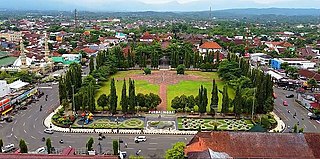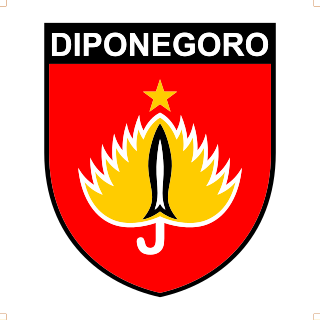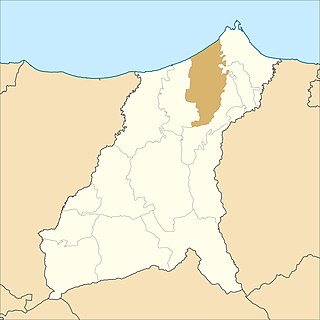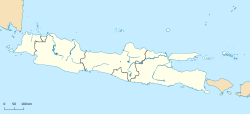
Central Java is a province of Indonesia, located in the middle of the island of Java. Its administrative capital is Semarang. It is bordered by West Java in the west, the Indian Ocean and the Special Region of Yogyakarta in the south, East Java in the east, and the Java Sea in the north. It has a total area of 34,337.48 km2, with a population of 36,516,035 at the 2020 Census making it the third-most populous province in both Java and Indonesia after West Java and East Java. The official population estimate in mid-2022 was 37,032,410. The province also includes a number of offshore islands, including the island of Nusakambangan in the south, and the Karimun Jawa Islands in the Java Sea.

Tegal is a city in the northwest part of Central Java of Indonesia. It is situated on the north coast of the province of Central Java, about 175 km (109 mi) from Semarang, the capital of the province. It had a population of 239,599 at the 2010 Census and 273,825 at the 2020 Census; the official estimate as of mid-2023 was 262,781.

Pekalongan is a city of Central Java, Indonesia. It was formerly the seat of Pekalongan Regency on the northern coast of the province, but is now an independent municipality within the province. It covers a land area of 45.25 km2 and had a population of 281,434 at the 2010 Census and 307,150 at the 2020 Census; the official estimate as at mid 2022 was 309,742. The city is Central Java's most important port, and is known for its batik. Since December 2014, Pekalongan is a member of UNESCO's World's Creative Cities Network. Pekalongan is the first Indonesian city and first South East Asian city listed as member of UNESCO's World's Creative Cities Network.

Purbalingga Regency is an inland regency in the southwestern part of Central Java province in Indonesia. Purbalingga Regency has an area of 805.76 km2 and population of 848,952 at the 2010 census and 998,561 at the 2020 census, comprising 505,281 male and 493,280 female inhabitants; the official estimate as at mid 2023 was 1,027,333. The administrative capital is the town of Purbalingga.

Tegal Regency is one of the regencies in the northwest part of Central Java province of Indonesia, with an area of 983.9 km2 (379.9 sq mi). The administrative center used to be in Tegal City, in the northwest corner of the regency, but then Tegal City was administratively separated from the regency and formed into its own territory. The city was later replaced as the administrative center of Tegal Regency by Slawi Town, which is a suburb about 20 km (12 mi) to the south of the city and within the district boundary. The regency had a population of 1,394,839 at the 2010 Census and 1,596,996 at the 2020 Census; the official estimate as at mid 2023 was 1,654,836.

Blora is a regency in the northeastern part of Central Java province in Indonesia. Its capital is the town of Blora. The regency is located in the easternmost part of Central Java and borders the Bengawan Solo River and the East Java province. It covers an area of 1,955.83 km2 and it had a population of 829,728 at the 2010 Census and 884,333 at the 2020 Census; the official estimate as of mid-2023 was 901,621, comprising 450,993 males and 450,628 females.

Grobogan Regency is a regency located in northeastern part of the Central Java province in Indonesia. Created on 4 March 1726, the Grobogan Regency has an area of 2,023.84 km2, and is the second largest regency in the Central Java Province. It had a population of 1,308,696 at the 2010 census and 1,453,526 at the 2020 census; the official estimate as at mid 2023 was 1,514,301. Its capital is the town of Purwodadi.

Kendal is a regency in the northern part of Central Java province in Indonesia, west of Semarang. The regency is bordered by the Java Sea in the north, Semarang City and Semarang Regency in the east, Temanggung Regency in the south, and Batang Regency in the west. Kendal Regency was established on 28 July 1605. Its capital is the town of Kendal, which is also known as the City of Santri because there are thousands of Ponpes, especially in Kaliwungu District and it is also known as the City of Arts and Culture. The regency covers an area of 1,002.23 km2 and had a population of 900,313 at the 2010 census and 1,018,505 at the 2020 census;</ref> the official estimate as at mnid 2022 was 1,053,440, consisting of 531,754 (50.48%) males and 521,646 (49.52%) females.

Pekalongan Regency is a regency on the north coast of Central Java province in Indonesia. It covers an area of 836.13 km2 and had a population of 838,621 at the 2010 census and 968,821 at the 2020 census; the official estimate as at mid 2022 was 986,455. Its administrative centre was formerly at Pekalongan City, but since that city was administratively separated from the regency, the regency's capital is now at Kajen, which is located in the middle of the regency, about 25 km south of Pekalongan City. Pekalongan residents are well known for their pursuit of perfection regarding the Indonesian traditional clothing called Batik.

Javanese cuisine is the cuisine of Javanese people, a major ethnic group in Indonesia, more precisely the province of Central Java, Yogyakarta and East Java.

KODAM IV/Diponegoro or IV Military Regional Command/Diponegoro is a military area command of the Indonesian Army. It covers the provinces of Central Java and Special Region of Yogyakarta on the island of Java. It is named after the Java War hero Prince Diponegoro. It appears to have been first established in 1950, and inherited the heritage of the former 3rd Diponegoro Division and other Central Java infantry units. Diponegoro Division personnel have been very significant in the history of the Indonesian Army. Among its early officers were Sarwo Edhie Wibowo, who served as battalion and regimental commander in the division from 1945-53. Former commanders of the division include Soeharto, a former president of Indonesia. Divisional personnel, including Lieutenant Colonel Untung Syamsuri, were involved in the 30 September Movement events of 1965. Former president Susilo Bambang Yudhoyono was also member of this KODAM when he took command of KOREM 072/Pamungkas at Yogyakarta during his military tenure.
Banyumasan, also known as the autoglottonymNgapak, is a dialect of Javanese spoken mainly in three areas of Java that is the Banyumasan, located in westernmost Central Java province and surrounding the Slamet mountain and Serayu River; a neighboring area inside West Java province; and northern region of Banten province. This area includes Cilacap, Kebumen, Banjarnegara, Purbalingga, Banyumas, Pemalang, Tegal, and Brebes regencies, together with independent cities within that region. Banyumasan is considered as one of the most conservative Javanese dialects, retaining the phonology and some aspects of Old Javanese grammar in the modern language.

Madiun Regency is a landlocked Regency in East Java province, Indonesia. It covers an area of 1,010.86 km2, and had a population of 662,278 at the 2010 Census and 744,350 at the 2020 Census; the official estimate as of mid-2023 was 747,589. It is bordered by Bojonegoro Regency in the north, Nganjuk Regency in the east, Ponorogo Regency in the south, and Magetan Regency and Ngawi Regency in the west, while the independent city of Madiun is an enclave within the regency.

Amat Antono is an Indonesian politician who served as the regent of Pekalongan Regency, Central Java for two terms, 2001–2006 and 2011–2016. Initially elected as regent of his home regency through a legislative vote, he lost in its first direct election to his deputy Siti Qomariyah before defeating her in 2011.
The Comal River is a river in Jawa Tengah, Indonesia. It rises in the North Serayu Mountains from Mount Slamet. The river has a length of around 109.18 km flowing from south to north, ending in Java Sea. It is the largest river in Pemalang Regency, Central Java, and flows through seven districts within that regency.

Petarukan is a district in Pemalang Regency, Central Java, Indonesia. Petarukan district contains 1 urban village (kelurahan) and 19 rural villages (desa).
The 2023 Liga 3 Central Java is the eighth season of Liga 3 Central Java organized by Asprov PSSI Central Java.



















